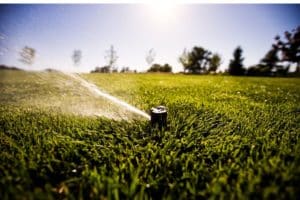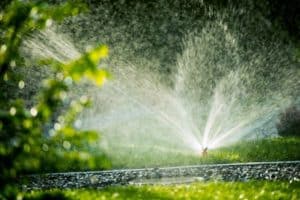Is your lawn looking a little thirsty or patchy? If you’re wondering about the best time to water grass in Cleveland, you’re not alone. Many Cleveland homeowners struggle with maintaining a healthy, green lawn, especially with the area’s unpredictable weather and seasonal shifts. The good news is that knowing when and how to water your lawn makes all the difference.
In this post, we’ll focus on the best watering times, why it matters, and key tips to keep your Cleveland lawn thriving.
Best Time to Water Grass in Cleveland

The best time to water grass in Cleveland is early in the morning, between 4 a.m. and 10 a.m. During this time, temperatures are cooler, and winds are calmer, allowing more water to be absorbed into your lawn instead of evaporating. This also helps your grass dry out before nightfall, which reduces the risk of disease, mold, and fungus.
By prioritizing early morning watering, you set your lawn up for success with deeper roots and less stress during the hot summer months.
Why Timing is Important for Watering
Watering at the wrong time of day can lead to several issues:
- Wasted Water: Water evaporates quickly in the heat of the day.
- Shallow Roots: Watering too frequently but at the wrong time doesn’t promote strong root growth.
- Increased Disease Risk: Watering in the evening can leave moisture on the blades overnight, encouraging mold and fungus.
How Much Water Does Your Lawn Need?

Understanding the right amount of water is crucial to your lawn’s health. Overwatering or underwatering can both be harmful, so finding the balance is key.
General Rule of Thumb
Your lawn needs about 1 to 1.5 inches of water per week, whether it comes from rainfall or irrigation. This amount ensures the soil is soaked to a depth of about 6 inches, promoting deep root growth and better drought resistance.
Adjust for Weather
During hot spells, your lawn may need more water. In cooler or rainy periods, it might need less. Always check the forecast to adjust your watering schedule.
Deep Watering
It’s more beneficial to water deeply but infrequently. Shallow watering encourages grass roots to stay near the surface, leaving your lawn vulnerable during droughts. Watering deeply helps develop a strong root system that allows your lawn to thrive long-term.
How to Water Your Lawn
Proper watering technique is just as important as knowing when and how much to water. Here’s how to maximize your watering efforts:
Water Early in the Morning
Watering between 4 a.m. and 10 a.m. allows the water to soak into the soil before the sun is at its peak, reducing evaporation.
Water at the Right Pressure
Too much pressure can cause water to run off before it has time to soak into the soil. Adjust your sprinkler to ensure water is gently absorbed into the ground.
Use a Watering Gauge
To monitor how much water is being applied, use a rain gauge or a container (like a tuna can). When you see about 1 inch of water in the container, you’ve watered enough for the day.
Avoid Watering at Night
While it might seem like a convenient time, watering at night can leave your grass wet overnight. This increases the risk of disease, mold, and fungus since the moisture stays on the blades longer than if watered in the morning.
Choosing the Right Sprinkler for Your Lawn
Selecting the appropriate sprinkler is essential for efficient water distribution across your lawn. Here’s a breakdown of different sprinkler types:
Rotary Sprinklers
Ideal for larger areas. They can cover a wide range with their rotating spray pattern, delivering water more slowly and evenly.
Oscillating Sprinklers
Best for rectangular or square lawns. They provide even coverage with a side-to-side motion, ideal for smaller lawns.
Stationary Sprinklers
Perfect for smaller, specific areas. You can set them to water particular patches of grass or garden beds.
Impact Sprinklers
Effective for larger lawns and can be adjusted to cover various distances, ensuring even water distribution.
Tip: Be sure to regularly check that your sprinkler heads are not clogged and that they are watering evenly. An uneven distribution can lead to dry patches or water wastage.
How Cleveland’s Climate Affects Your Lawn
Cleveland’s unpredictable weather can complicate lawn care, but understanding its patterns can help you water more effectively. Here’s a breakdown of the seasons:
- Spring: The Soil remains moist from snowmelt and rain. Watering needs are minimal.
- Summer (especially July & August): Higher temperatures increase evaporation, and dry spells make watering more crucial.
- Early Fall: Consistent rainfall and cooler temps mean you can cut back on watering while still encouraging deep root growth for the winter.
How Often Should You Water Your Lawn in Cleveland?
Many homeowners assume that watering every day is best, but this can actually do more harm than good. Instead, follow the “deep and infrequent” rule:
- Water 1–2 times per week
- Aim for about 1 inch of water per session
- Adjust frequency during heat waves or rainy spells
This encourages deep-root growth, making your lawn more drought-resistant and healthier over time.
Common Watering Mistakes to Avoid
Avoiding these missteps can save your grass—and your water bill:
- Watering at night: This leaves moisture sitting on the grass, leading to disease.
- Watering too little: Light daily watering creates shallow roots.
- Ignoring weather forecasts: Save water and avoid overwatering by checking the rain schedule.
- Sprinkler inefficiency: Broken or poorly placed heads can lead to dry patches or runoff.
Know Your Grass Type
Not all lawns need the same amount of water. The type of grass you have can determine how often—and how much—you should be watering.
Here are a few common grass types in the Cleveland area:
Kentucky Bluegrass
A popular cool-season grass that thrives here, but it needs about 1 to 1.5 inches of water per week. It can go dormant in heat, so don’t panic if it browns a bit in late summer.
Perennial Ryegrass
Fast-growing and ideal for high-traffic areas, but it has a shallower root system, so consistent watering (without overdoing it) is key.
Fine Fescue
A low-maintenance option that tolerates shade and drought better than most. It often requires less frequent watering than bluegrass or ryegrass.
Conclusion
Watering your lawn in Cleveland is about timing, technique, and understanding your grass’s needs. By watering early in the morning and adjusting for weather, you’ll help your lawn thrive. For expert help or to optimize your irrigation system, consider reaching out to a professional irrigation company. Take the next step and apply these tips for a lush, healthy lawn. Happy watering!
